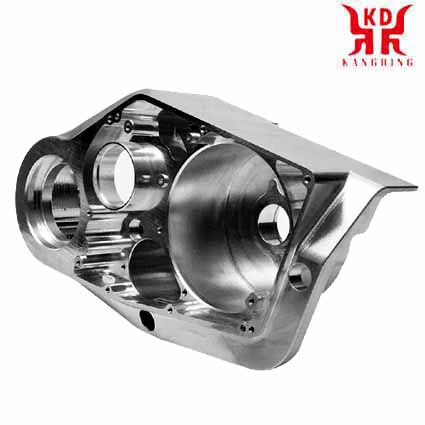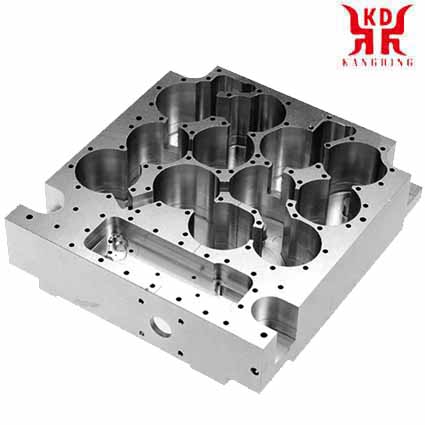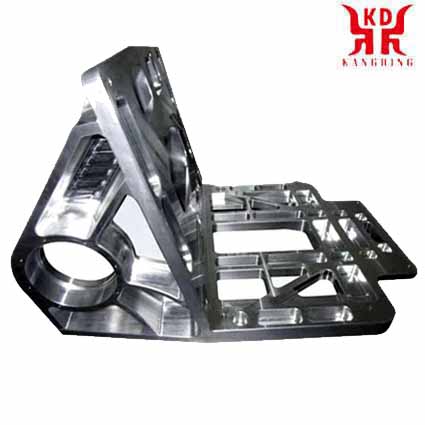Bol som v dielni a pýtal som sa sám seba, čo je dôležité pri frézovaní hliníka, aby sa získali dokonalé diely.
Tak som začal bádať, kotúľať sa v knihách a prehľadávať polovicu internetu. Všetko, čo som mohol nájsť o frézovaní hliníka, som zhrnul v tomto článku.
Na čo si dať pozor pri frézovaní hliníka?
Z technického hľadiska, komponenty vyrobené z hliníka s lešteným povrchom a rozmerovou presnosťou 1/100 mm a menej je možné vyrobiť.
Avšak, aby sa dosiahla veľmi vysoká kvalita povrchu a dobrá rozmerová presnosť, pri frézovaní hliníka musia byť okrajové podmienky správne.
stopková fréza

5-osové frézovanie hliníkových dielov
Na rozdiel od spracovania dreva a ocele, hliník môže zmäknúť v dôsledku tepla generovaného počas frézovania. Roztavený hliník potom môže prilepiť rezné hrany frézovacieho nástroja.
Ako výsledok, triesky sa už nedajú vybrať, priestor na triesky sa upcháva a nové triesky sa už nerežú. Nevyhnutným výsledkom je nepoužiteľný povrch a zlomenie frézovacieho nástroja.
Frézovanie hliníka – 6 dôležité parametre
Aby ste mohli ideálne frézovať hliník, mali by ste poznať najdôležitejšie parametre a vlastnosti procesu obrábania.
Pre špičkový výsledok frézovania, správna interakcia medzi fyzikálnymi vlastnosťami hliníkovej zliatiny, je potrebný frézovací nástroj a parametre stroja. Správne nastavený proces frézovania rozhoduje o tom, či je proces obrábania úspešný alebo nie.

Základy obrábania hliníka
The 6 Najdôležitejšie parametre pri frézovaní hliníka sú:
Typ hliníkovej zliatiny
Typ frézy (materiál a počet rezných hrán)
Výška rýchlosti posuvu
Výška rýchlosti frézy
Typ chladiaceho maziva (KSS)
Metóda frézovania
Títo 5 parametre sú podrobnejšie vysvetlené nižšie:
Ktoré zliatiny hliníka použiť na frézovanie?
Výber vhodného hliníkového materiálu je polovica úspechu. Mäkké hliníkové plechy zo železiarstva sú pomerne náročné na opracovanie.
Aluminum with defined alloy additives can be many times stronger than pure aluminum. It can also be said that brittle alloys with higher tensile strength are easier to machine.
“Brittle alloys with higher strength are easier to machine.”
If you cannot specify a DIN designation when ordering your material, please ensure that you request at least aluminum in turning / milling quality.
As is well known, napr. the alloys EN AW-2007 and EN AW-6012 are typical free-cutting alloys. The high-strength “aircraft aluminum” EN AW-7075 is usually very easy to machine.
The following table shows the suitability of frequently used aluminum alloys for milling:
EN designation No. old norm Machining welding Anodizing Yield strength min.
[N / mm²]
EN AW-1050A 3.0255 Al99,5 (Reinalu) bad mittel gut 20
EN AW-2007 3.1645 AlCuMgPb very good bad bad 210
EN AW-2011 3.1655 AlCuBiPb very good bad bad 195
EN AW-2017 3.1325 AlCuMg1 very good bad bad 220
EN AW-2024 3.1355 AlCuMg2 Well bad bad 270
EN AW-5083 3.3547 AlMg4,5Mn Well very good Well 110
EN AW-5754 3.3535 AlMg3 middle Well Well 70
EN AW-6012 3.0615 AlMgSiPb very good bad bad 200
EN AW-6026 – AlMgSiBi Well Well Well 240
EN AW-6060 3.3206 AlMgSi0,5 middle Well Well 160
EN AW-6061 3.3211 Mg1SiCu middle very good bad 230
EN AW-6063 – AlMg0,7Si middle middle Well 110
EN AW-6082 3.2315 AlMgSi1 Well Well middle 200
EN AW-7020 3.4365 AlZn4,5Mg1 Well middle middle 270
EN AW-7075 3.4365 AlZnMgCu1,5 very good bad middle 400

Aluminum parts are milled correctly
Selection of milling cutters for machining aluminum
End mill
The shorter and thicker the cutter, the greater its stability and strength. A stable cutter prevents the cutter from swinging and breaking. Similar to milling all other materials, the following rule of thumb also applies to aluminum:
“The milling cutter has to be as thick as possible and as short as possible.”
Navyše, the free removal of the chips by the milling cutter must be guaranteed for a good milling result. The single-edge milling cutter has the best chip evacuation, as this is where the chip space is greatest. Avšak, the lower the number of cutting edges, the higher the load on the individual cutting edge as a rule.
For this reason, a compromise must be made between cutting edge load and good chip evacuation when milling aluminum.
Inexpensive milling cutters are not recommended because the cutting edges quickly become blunt and the service life of the milling cutter is significantly shorter than with high-quality milling cutters.
Pôvodne sa uvádzalo, že jednobřitá fréza nie je vhodná na obrábanie hliníka. Našťastie, mimoriadne znalý čitateľ (JACK) opravil môj nesprávny úsudok a upozornil, napríklad, takzvaný “rezačka s jedným zubom s jastrabím zobákom” z VHF, ktorý je v skutočnosti obzvlášť vhodný na obrábanie hliníka!
Rýchlosť a rýchlosť posuvu
Rýchlosť rezania (kombinácia rýchlosti a rýchlosti posuvu) má tiež podstatný vplyv na výsledok pri frézovaní hliníka.
Orientačné hodnoty:
Rezná rýchlosť pre hliník: vc ~ 100 m / min pre vysokokvalitné HSS frézy.
Krmivo pre hliník: fc ~ 0.1 mm na reznú hranu. S trojrezom je to tak 0.3 mm posuv na otáčku frézy.
V technických tabuľkách (napr. kovová stolová kniha) môžete nájsť alebo vypočítať smerné hodnoty rýchlosti, veľkosť a posuv rôznych nástrojov a zliatin.
The speed of the milling cutter is calculated using the following relationship:
n = vc / d x pi
n = speed of the milling cutter in rpm
vc = cutting speed in mm / min
d = cutter diameter in mm
pi = circle number (3.14)
The feed rate of the milling cutter is calculated using the following formula:
vf = n * z * fz
vf = feed speed in mm / min
n = milling cutter speed in rpm
z = number of cutting edges on the milling cutter
fz = tooth feed in mm / zub
Example calculation:
3 cutters with 6 mm cutter diameter.
Cutting speed vc = 100 m / min = 100 * 1000 mm / min
Milling cutter diameter d = 6 mm
Milling speed n = 5300 rpm
Feed fz = 0.1 mm / rev
-> feed speed vf = 1600 mm / min
For all lazy CNCers there is also a calculation tool for determining the cutting data.
Choosing the coolant when milling aluminum
Konečne, you should think about the right cooling.
The general question is whether to work with or without cooling lubricant.
The disadvantages of wet milling are high temperature fluctuations in the cutting edge, which lead to a shorter tool life. The fluctuations are smaller with dry milling. When roughing, you should work dry if possible.
Some hobbyists also use petroleum / alcohol from the squirt bottle for cooling. I do not recommend this, však, as petroleum / alcohol is easily flammable and therefore dangerous. If you work with minimum quantity lubrication, make sure to use a suitable cooling lubricant for aluminum.
Poznámka: When using water-based cooling lubricants, please clean the machine completely after using the KSS.
In the event of a longer standstill, the water separates from the emulsion and causes your milling machine to rust.
Ďalej, standing cooling lubricant can easily accumulate fungi and bacteria, which is why special fungicides are often necessary as an additive in the cooling lubricant.
Metóda frézovania
The choice of milling method, such as up-cut milling, down-cut milling, circular milling, helical milling or trochoidal milling (whirl milling) also has a direct influence on the milling result. Trochoidal milling increases the tool life enormously.
The following video shows what exactly trochoidal milling is.
A frequent tip is to continue to ensure sufficient delivery. Infeeds of 0.3 mm or less place a heavy load on the cutting edge and lead to faster tool wear. Just be brave and experiment with slightly higher infeeds.
Application examples
Tons of aluminum parts are milled every day.
Typical application examples range from machine and vehicle construction, through engraving of signs to lightweight components in aircraft construction.
The face milling of sealing surfaces on engine or gear housings is just as much a part of everyday aluminum milling tasks as the production of fashionable aluminum jewelry.
Other readers were also interested in:
How are plastics properly milling?
 English
English العربية
العربية 中文(漢字)
中文(漢字) Čeština
Čeština Dansk
Dansk Nederlands
Nederlands Suomi
Suomi Français
Français Deutsch
Deutsch Italiano
Italiano 日本語
日本語 ಕನ್ನಡ
ಕನ್ನಡ 한국어
한국어 Português
Português Русский
Русский Slovenčina
Slovenčina Español
Español Svenska
Svenska Türkçe
Türkçe

